Two of a kind?
2020 Honda CRF1100L Africa Twin and Africa Twin Adventure Sports ES Review
A new decade marks a facelift for Honda’s Africa Twin and the Africa Twin Adventure Sports. Has more tech equaled a better ride?

Photography by Kit Palmer
We’ve been big fans of the Honda Africa Twin since it arrived on the scene in 2016. Since then, it’s won two comparison tests and finished a close second in the third test, even though it was essentially the same machine since it debuted in 2016.
The 2018 model year saw a few updates like seven-stage traction control and little motor tweaks, plus the arrival of the Adventure Sports version with more fuel capacity and longer-travel suspension, aimed more at touring riders who like to venture down a dirt road occasionally.
For this year, however, the two Africa Twins have been separated further, with the base model now a much sportier off-road prospect and the Adventure Sports further aligned with its touring persona.
The base model comes standard with a five-gallon gas tank; compact, rally-style bodywork with a short, fixed screen; skinny handguards; revised fully adjustable suspension; and tubed, spoked wheels that off-road riders will love.
The Adventure Sports comes with a host of goodies including three-stage cornering lights; a 6.5-gallon gas tank; wider front fairing compared to the base model; tubeless spoked wheels; a tall, adjustable windscreen; rear luggage rack and larger skid plate; a lower seat height compared to the 2019 AS; heated grips; and an accessory charger as standard.
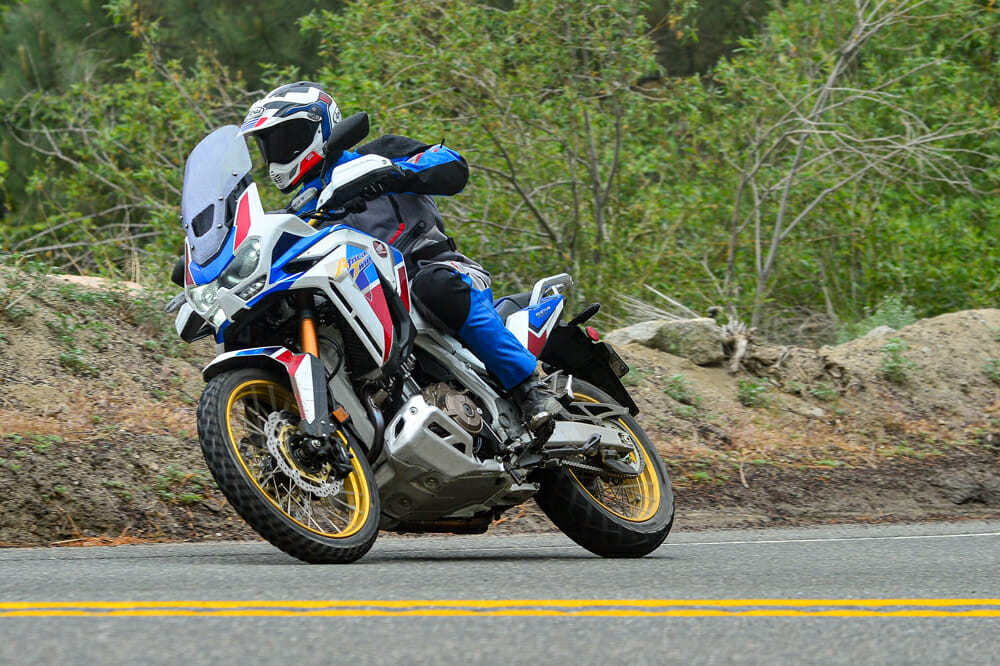
Under the Hoods
Both the $14,399 (base) and $17,199 (non-DCT) Adventure Sports have come in for fairly significant overhauls for 2020. At the heart of both machines is a new 1084cc (formerly 998cc) parallel-twin engine. The increased displacement arrives via a 6.5mm longer stroke with a claimed six-percent increase in power (although Honda won’t say how much that power actually is). Inside there are new pistons, crank and cams with longer intake and exhaust-valve lifts (the intake is up from 9.2mm to 10.1mm while the exhaust is increased from 8.6mm to 9.3mm).
Up top, the throttle body has grown two millimeters in diameter to 46mm, the intake has been straightened up for a smoother air tract and the ECU gets new fuel-injector settings to help smooth out the initial throttle response.
You can play around with the spec of your new Africa Twin at the dealer, where you can have the traditional manual or the DCT semi-automatic gearbox on either model. However, you can only have the Showa electronic suspension on the Adventure Sports edition. More on that later.
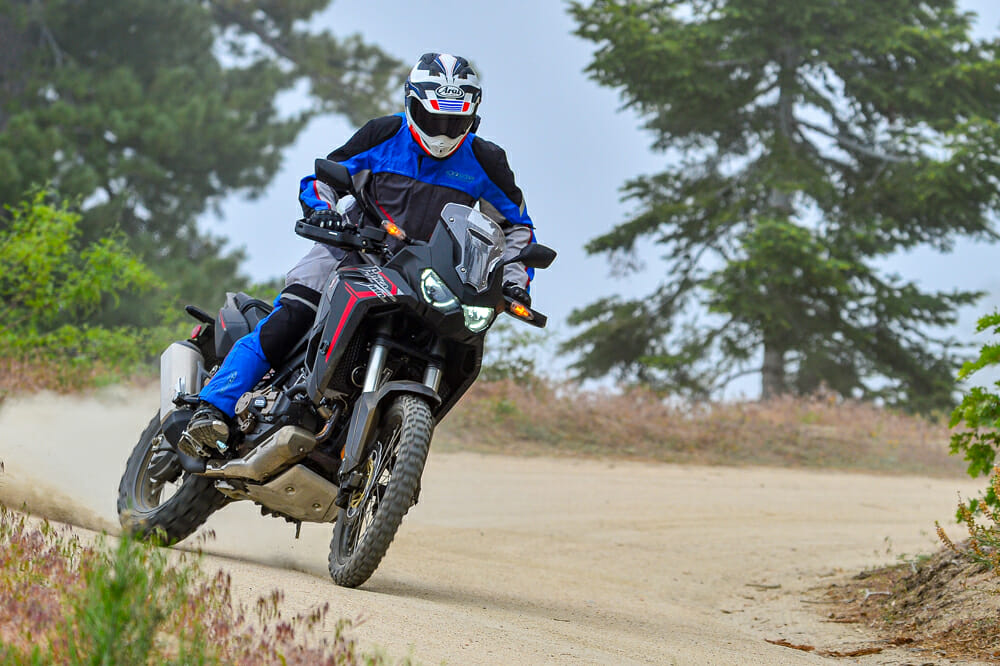
The manual gearbox comes in for an all-new, stronger gearset and a new, smaller diameter slip-and-assist clutch for a lighter lever pull.
On the DCT side, this is where Honda has put most of its cookies. They’ve been trying to perfect this design since the Honda VFR1200 of a decade ago, and much of the Africa Twin’s overall R&D budget will have gone into making the DCT a real off-road alternative.
The 2020 Africa Twins come with a six-axis IMU for the first time and this works hand-in-hand with the DCT’s performance. Cornering detection is now built into the system, whereby the ECU recognizes the bike is cranked over and won’t suddenly change gear on you, which leads to the inevitable chassis unbalancing. As before, you get three transmission modes—AT D (Drive), AT S (Sport) and MT (Manual, operated by shift levers on the left handlebar)—with new shift timing for each. There’s also the G switch, which essentially lets the clutch engage quicker (think of it as a short versus a longer lever pull on a traditional clutch lever). The result you’ll feel is a quicker throttle response, almost like a more direct throttle map.
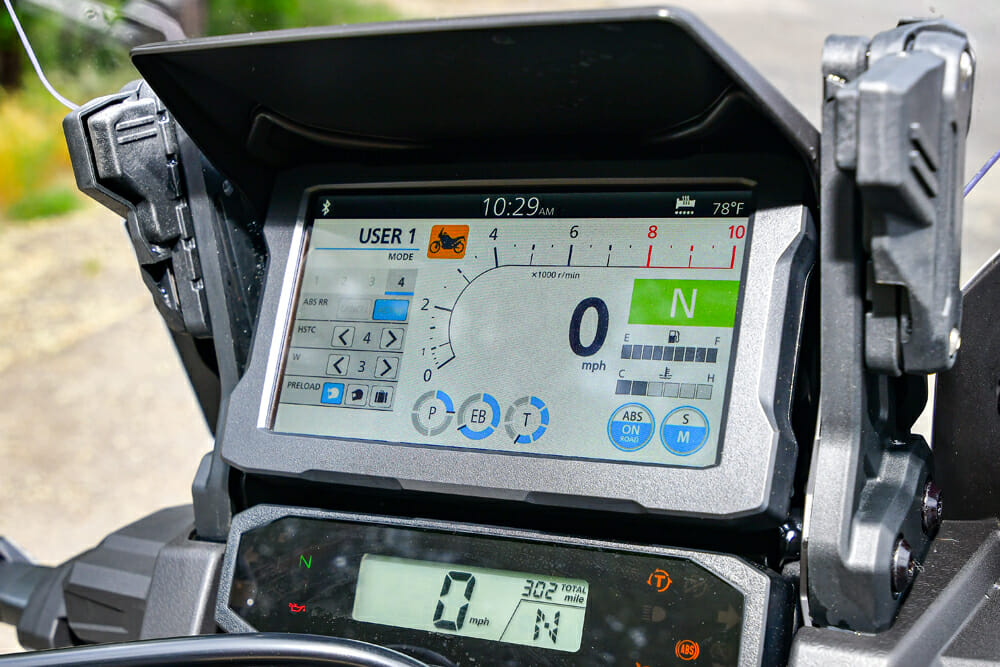
Chassis Development
The two bikes share the same main chassis and swingarm, with their only major differences being the suspension. There’s a smattering of CRF450R motocrosser in the new Africa Twin, with the subframe and swingarm modeled off it. The new, lighter subframe is now separate to the main frame and 40mm narrower at the seat rails, while the swingarm is stiffer and a pound lighter than before.
The main chassis does away with the cross pipe at the top of the shock, which is now centrally-mounted in the frame/swingarm, and the steering head’s been beefed up for more rigidity and front-end feel through the ’bars. This factor is also helped by the main frame having straighter main spars.
As for the base model, suspension consists of conventionally operated 45mm Showa inverted forks with 9.1 inches of travel, mated to a Showa shock giving 8.7 inches of travel.
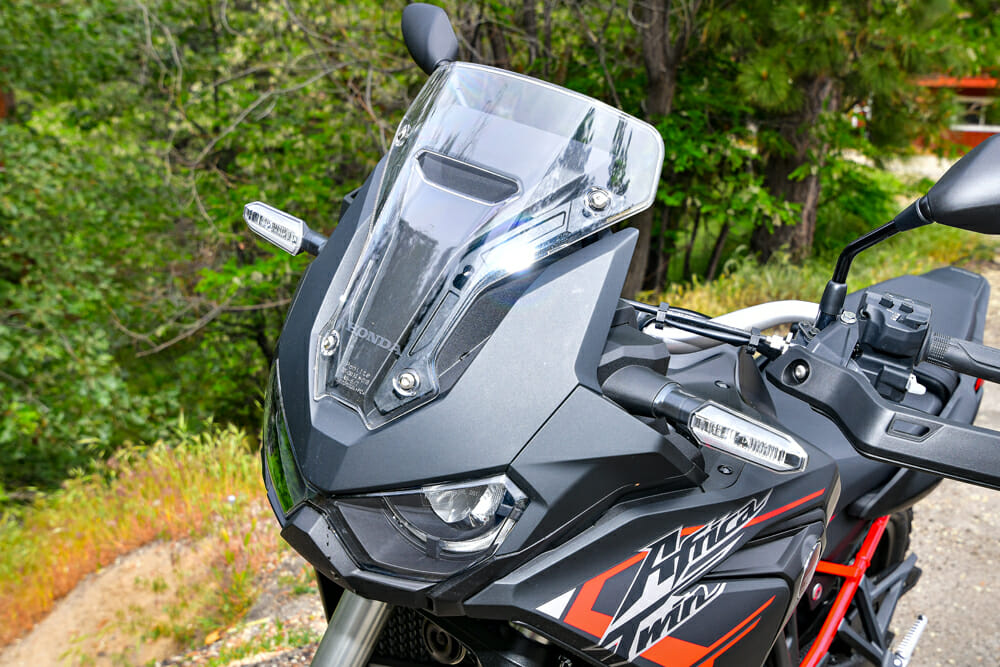

The difference is the Adventure Sports comes with a 45mm Showa fork, those, too, with 9.1 inches of travel and a Showa monoshock with 8.7 inches of travel, but they run the Showa Electronically Equipped Ride Adjustment Suspension (EERA) system that contains four different modes (Hard, Mid, Soft and Off Road), as well as electronic preload adjustment, which has its own settings of Rider, Rider/Luggage, Rider/Passenger, and Rider/Passenger/Luggage. Like the Öhlins system fitted to the Ducati Multistrada, for example, the Showa system is dynamic and monitors suspension behavior in real time and adjusts the damping to suit. However, unlike the Öhlins system, there’s no manual mode on the Showa’s.
As for the brakes, they are the same across both models in the dual front four-piston Nissin radially mounted calipers biting 310mm discs, and a single-piston caliper clamping a 256mm disc at the rear. Cornering ABS is mandatory, of course, but comes with an Off-Road mode.
Overall, the base model has dropped a claimed six pounds to measure 501 pounds for the manual and 524 pounds for the DCT. The Adventure Sports has lost three pounds to measure a claimed 530 pounds for the manual and 553 pounds for the DCT.
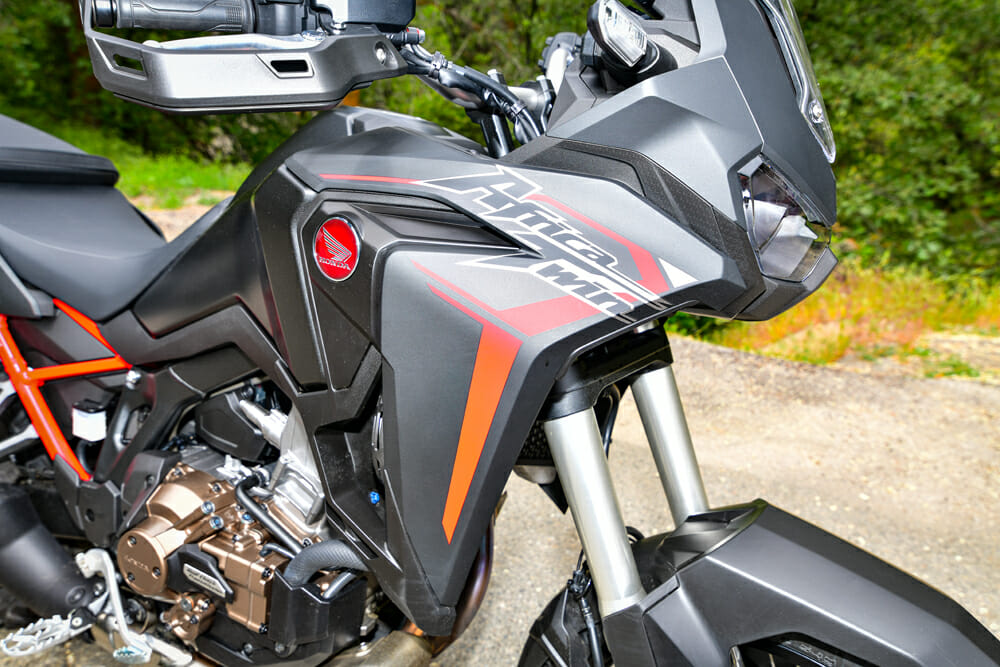
Range—Electronics
Even after the motor and chassis changes, the biggest change for the new decade of Africa Twins comes in the electronics. Part of the appeal of the old model was its basic electronic layout—that’s all gone, as Honda goes head-long against electronic stalwarts BMW and KTM to see just how many gadgets they can fit on their ADV bikes.
As mentioned, the Adventure Sports gets the Showa electronic suspension, adjustable via the new 6.5-inch TFT display touchscreen dash that has three different display settings. The suspension allows for 24 different possibilities within each of the four modes, as it will let you change compression, rebound and preload within a given mode.
However, both bikes come with a Bosch six-axis IMU, four preset riding modes and two customizable modes that let you fiddle with engine power output, traction-control level, engine brake control, G Switch level, suspension damping (on the Adventure Sports) and wheelie control. You also get, for the first time on any Honda other than a Gold Wing, cruise control, and the dash comes with Apple Car Play, so you can use the dash just as you would an iPhone.
Thankfully, Honda has not linked the traction control to the various ride modes like they did on the 2017 CBR1000RR, so you can vary the amount of TC you want regardless of mode.
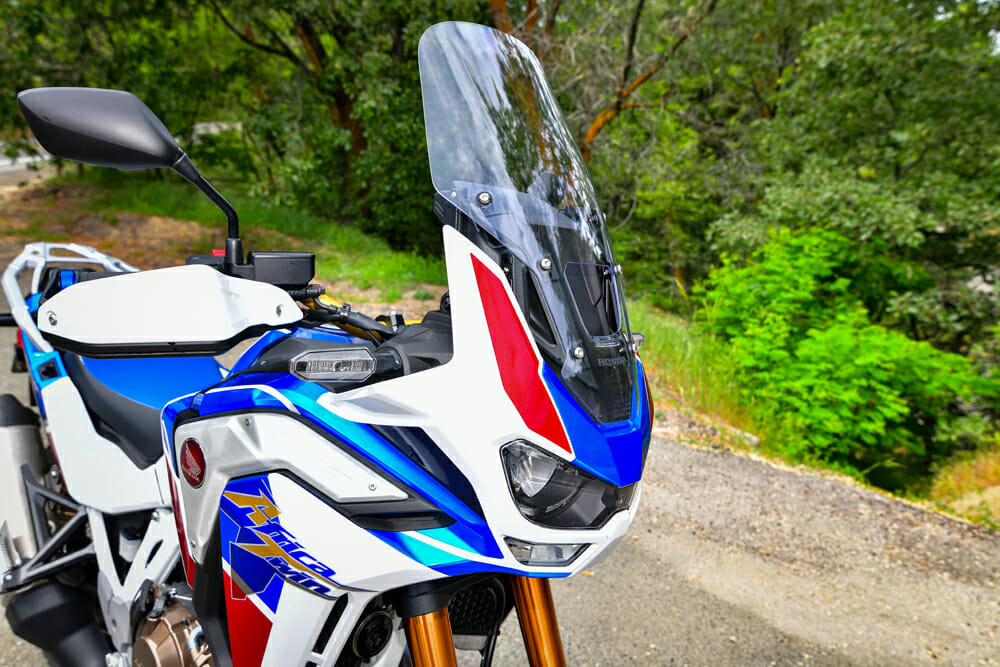
From the hotseats
For our test on the base model, Honda threw us a curveball and gave us one with the semi-auto DCT so we could really test it out off the beaten path.
Our thinking was we’d get a DCT on the Adventure Sports, so we’d get the DCT and semi-auto suspension in one package (which is what I assume most buyers will go for). Instead, we’ve got a conventional gearbox on our AS. Those crazy Honda cats.
The off-road DCT behavior takes a little getting used to. The first mode of Drive is next to useless on dirt, as it’s always forcing you into a higher gear than you’d normally use. This has the added issue of giving you less engine braking than you may want when you roll off the throttle—something far from ideal off road.
In the Sport mode, things are a little better, but still not perfect. Sport mode allows for the transmission to hold a gear longer than Drive, enabling you to max out the available acceleration for that particular gear. On dirt roads, the Sport mode works reasonably well, but take it up some snotty, rock-strewn hills and you’ll see the system’s limits pretty quickly.
The DCT still doesn’t know when to shift correctly, especially when the rear wheel comes off the ground under acceleration. During one particular photo session, the system would continually shift from second to third gear at the wrong time, losing the needed drive to get up the hill. Once things leveled out, the DCT’s behavior was more predictable, but it was still an annoying trait.
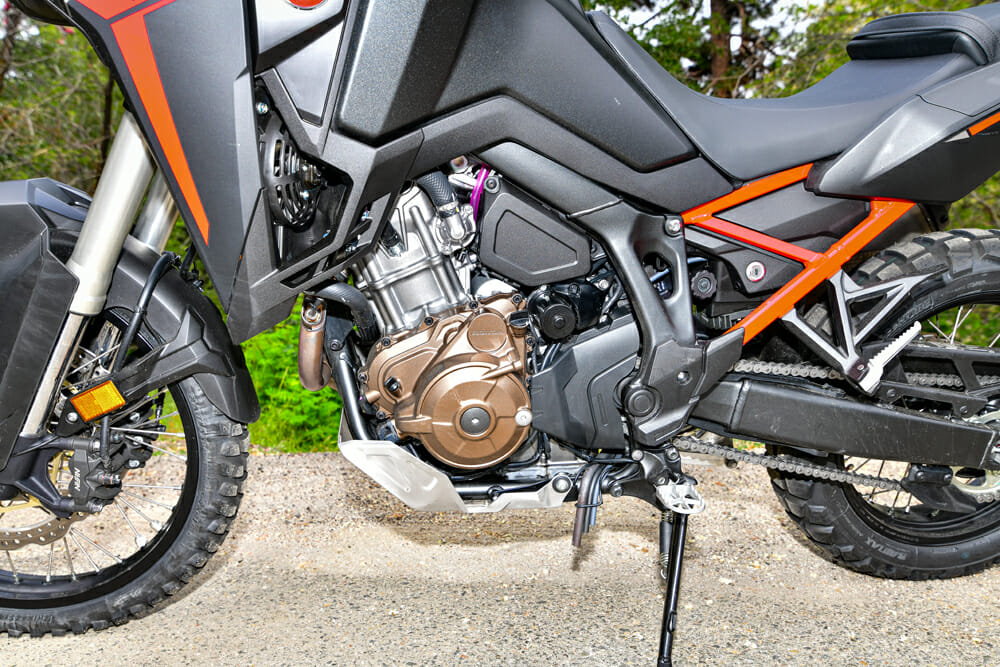
Another issue was freewheeling. A number of times I would come over a crest, the revs would peak out (as though spinning the rear wheel), and I’d use the rear brake to calm the rear suspension. This seemed to cause the DCT system to drop all engine braking for a split second, like the clutch was pulled in all of a sudden, which threw me off course. After a scare, I tried to make the system do this again, which it did, twice. Needless to say, I wasn’t best pleased.
The only way to be properly confident with the DCT off road was to put it in the manual setting and change the gears via the paddle shifters on the left handlebar, at which point you may as well have the conventional manual gearbox on your base model.
The Adventure Sports off road with the conventional gearbox, on the other hand, allowed a more predictive character, despite the extra girth afforded by the bigger tank and ergonomics.
Where the Adventure Sports had a slightly vague feeling was in the electronic suspension. This is one of the better systems out there, but when riding off road, the electronic suspension just doesn’t have the tangible feel afforded by the conventional suspension on the base model. It’s a case of you know it’s working, but you really have to trust it.
On the street, the semi-active Showa system is excellent and gives a velvety smooth ride. With the adjustable modes, you’re almost guaranteed to find a setting that suits on the street but get real gnarly off road and you’ll start to feel the limits of the system.
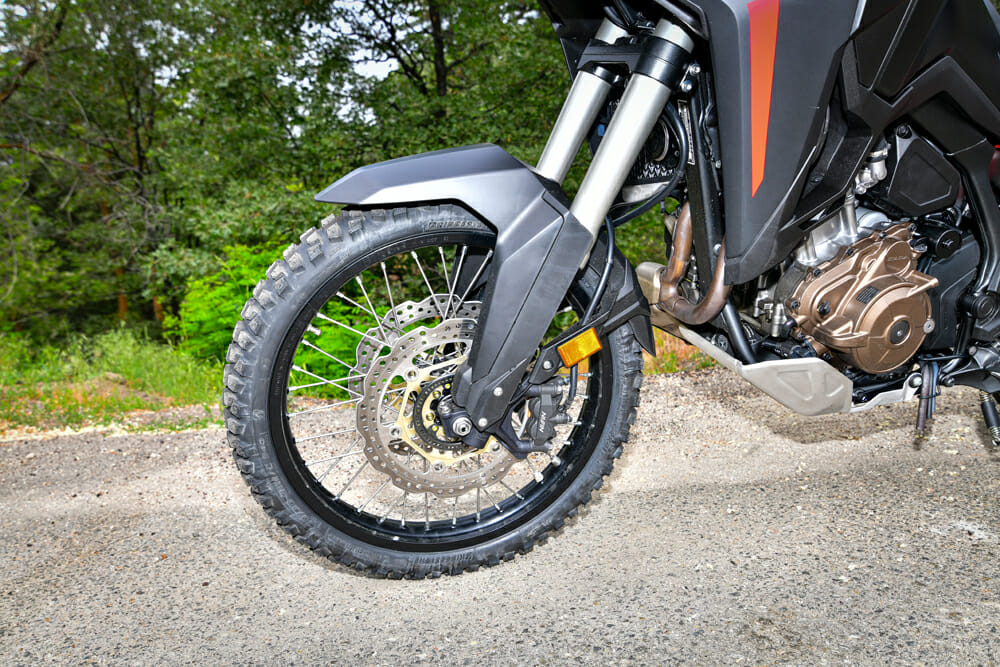
One point of the electronics I find perplexing was the wheelie control. For starters, I think it’s pointless on an ADV bike but its operation was strange, again, off road. Once TC was switched off for some uphill action, I’d get about a quarter of the way up before the bike would simply come to a halt—like the TC was on full noise. As it turns out, the wheelie control was cutting the power, even though no wheelie was going on, it was just the rear wheel spinning. Turn the Wheelie Control all the way off, and everything was sweet, but it was just another system that in my view didn’t need to be there causing unnecessary problems.
Considering both machines come with the same 1084cc motor, power is never an issue. The low-down throttle response and initial torque delivery on the DCT version is a little abrupt off road but transfer this to the street and you have one of the world’s fastest point-to-point machines underneath you. Gunning a DCT Africa Twin off the lights is an extremely surprising and downright funny experience. It simply munches most other bikes up to 60 mph, leaving you and the onlookers amazed at the sheer go available once you get rid of that pesky clutch lever.

On the street, both machines are absolutely grand. They’re so comfortable, so roomy, and ride the road so smoothly, it’s easy to see why Honda has sold so many. And now both models have cruise control, even better. The cruise control is on the right side of the handlebar, which is a bit of an annoyance, but hey, at least Honda fitted the system in the first place.
With the now adoption of myriad electronics in the AT lineup, Honda’s done an amicable job of trying to make the various systems easy to access and use/change, but I feel the interface is a little clunky. Honda’s rammed so much info into the dash that it’s a bit overwhelming to use and I feel they should have hired a top-notch UX designer to make the systems a bit more intuitive.
It’s not entirely Honda’s fault, as there’s just so much stuff to fiddle with, especially if you’re running the DCT and semi-auto suspension, but the execution simply wasn’t there for me.
If I were in the market for an Africa Twin, I’d likely go for the base model with a manual gearbox, simply because the suspension on the base model is excellent, it’s got a manual preload adjuster for a passenger, and you get cruise control.

The Adventure Sports (in DCT option) only makes real sense if you’re going mainly touring on road, with the occasional dirt road. However, I feel Honda has almost tried to be too smart for its own good. I loved the almost analog nature of the pre-2020 model for its excellent design execution and overall simplicity in a market that seems hell bent on throwing every electronic aid/feature it can at the rider, often unnecessarily. The 2020 editions are great bikes, but I long for the older ones. CN
VIDEO | 2020 Honda CRF1100L Africa Twin Review
2020 Honda CRF1100L Africa Twin/Adventure Sports ES Specifications

table.tableizer-table {
font-size: 12px;
border: 1px solid #CCC;
font-family: Arial, Helvetica, sans-serif;
}
.tableizer-table td {
padding: 4px;
margin: 3px;
border: 1px solid #CCC;
}
.tableizer-table th {
background-color: #FFFFFF;
color: #FFF;
font-weight: bold;
}
| MSRP: | $14,399/$15,199 DCT / $17,199/$17,999 DCT |
| Engine: | Liquid-cooled, parallel-twin, 4-stroke, 4-cylinder |
| Displacement: | 1084cc |
| Bore x stroke: | 92 x 81.5mm |
| Compression ratio: | 10.1:1 |
| Electronics: | 6-axis IMU, Honda Selectable Torque Control (HSTC), Cornering ABS, variable riding modes, engine brake control, G-Switch, Showa electronic suspension (EERA, Adventure Sports) |
| Transmission: | 6-speed manual / DCT semi-automatic |
| Clutch: | Wet multi-disc, manual / DCT semi-automatic |
| Chassis: | Aluminum twin-spar |
| Front suspension: | 45mm inverted Showa telescopic fork / 45mm inverted Showa telescopic fork w/ EERA |
| Rear suspension: | Pro-Link system w/ single Showa shock / Pro-Link system w/ single Showa shock w/ EERA |
| Front-wheel travel: | 9.1 in. |
| Rear-wheel travel: | 9.4 in. |
| Front brake: | Dual 4-piston hydraulic calipers, 310mm discs; ABS |
| Rear brake: | Single 1-piston hydraulic caliper, 256mm disc; ABS |
| Front tire: | 90/90-21 in. |
| Rear tire: | 150/70R-18 in. |
| Rake: | 27° |
| Trail: | 4.4 in. |
| Wheelbase: | 62 in. |
| Seat height: | 34.3 in. / 33.7 in. |
| Fuel capacity: | 5.0 gal. / 6.5 gal. |
| Weight (curb, claimed): | Base model: 510 lbs. / 524 lbs. with DCT. Adventure Sports: 530 lbs. /553 lbs. with DCT |
| Color: | Matte Black Metallic/Pearl Glare White/Blue |
